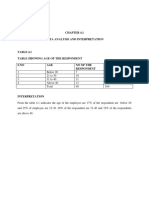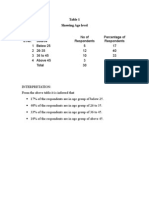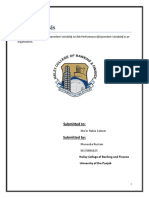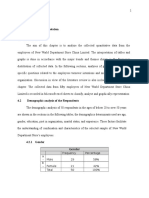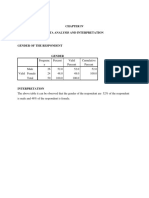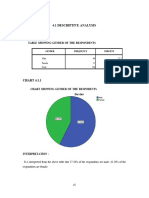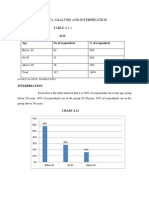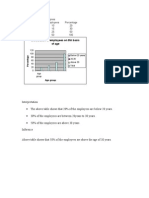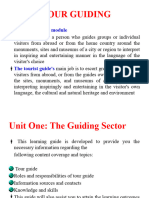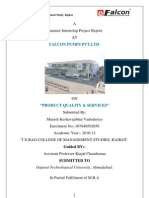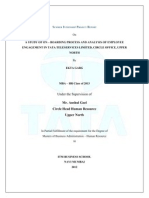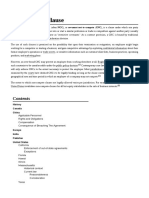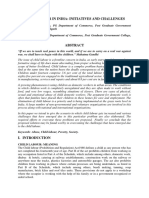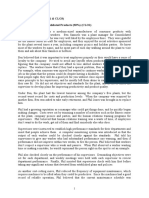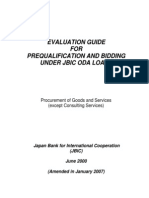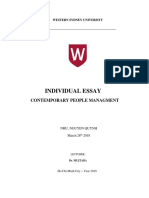Chapter 4 ANALYSIS AND INTERPRETATIONS 4.
1 PERCENTAGE ANALYSIS
Percentage analysis consists of reducing a series of related amounts to a series of percentages of a given base.
AGE
The age of respondents play a vital role in their job performance and beneficial contribution to the organization. Age indicates the level of maturity in each individual. As age increases the knowledge, abilities and experience tend to increase.
TABLE NO: 4.1.1 AGE WISE CLASSIFICATION OF THE RESPONDENTS
Age Below 25 Below 35 Below 45 Below 55 Above 55 TOTAL NOR 28 39 24 9 0 100 % of Respondents 28 39 24 9 0 100
From the above table it can be inferred that about 39% of the respondents belong to Below 35 age group. A minority of 28% of respondents belong to Below 25 age group. It is found that the organization is more focused in retaining employees under the age group of Below 35 years. This may be because the organization thinks that experienced staff can do better than the fresher.
�CHART NO: 4.1.1 AGE WISE CLASSIFICATION OF THE RESPONDENTS
�GENDER
The ratio of male to female workers is not equal in any organization. The ratio differs from organization to organization because of social reasons, nature of the job, geographical reasons and also due to the opportunities available.
TABLE NO: 4.1.2 GENDER WISE CLASSIFICATION
Gender Male Female TOTAL
NOR 77 23 100
%Of Respondents 77 23 100
The data shows that 77% of the respondents are male and 23% of the respondents are female.
CHART NO: 4.1.2
�GENDER
Female Male
Male
F a em le
EXPERIENCE
The distinction between the fresher and the experienced staffs is varied with their performance in the work place. More experienced staff occupies higher positions.
�Increase in years of experience to an extent indicates the employee satisfaction towards their job.
TABLE NO: 4.1.3 EXPERIENCE
Experience 0-5 Years 5-10Years 10-15 Years Above 15 Years TOTAL NOR 38 41 21 0 100 %Of Respondents 38 41 21 0 100
From the above table it can be inferred that a majority of 41% of the respondents have an experience of 5-10 years. . It is clear from the above table that most of the respondents are well experienced. About 21% of the respondents have an experience of 10-15 years. It is clear from the above table that most of the respondents are well experienced.
CHART NO: 4.1. 3
��QUALIFICATION
Qualification means a quality, ability, or accomplishment that makes a person suitable for a particular position or task. Qualification means any skill that fits a person for some work.
TABLE NO: 4.1.4 QUALIFICATION
Qualification Diploma holders Graduates & Above Other TOTAL NOR 37 40 23 100 % Of Respondents 37 40 23 100
The above table depicts that a majority of 40% of the respondents are Graduates & Above in the company. About 37% of the respondents are diploma holders.
��TRAINING REQUIREMENT
Most of the training activities in the company provide the employees on the job training. Most training activities seek to modify one or more of technical, interpersonal and problem solving skills etc. Different people require different kinds of training.
TABLE NO: 4.1.7 TRAINING REQUIREMENT
Training Requirement NOR % Of Respondents
Time Management Stress Management Techniques Performance Development Skills TOTAL
26 23 61 100
26 23 61 100
The above table depicts that 61% of the respondents suggests that performance development skills training is required to perform the current job in an effective way. The table shows that the employees need further training programs, which w
�ill bring better performance in their current job. Some of them require time management and stress management programs.
CHART NO: 4.1.7

